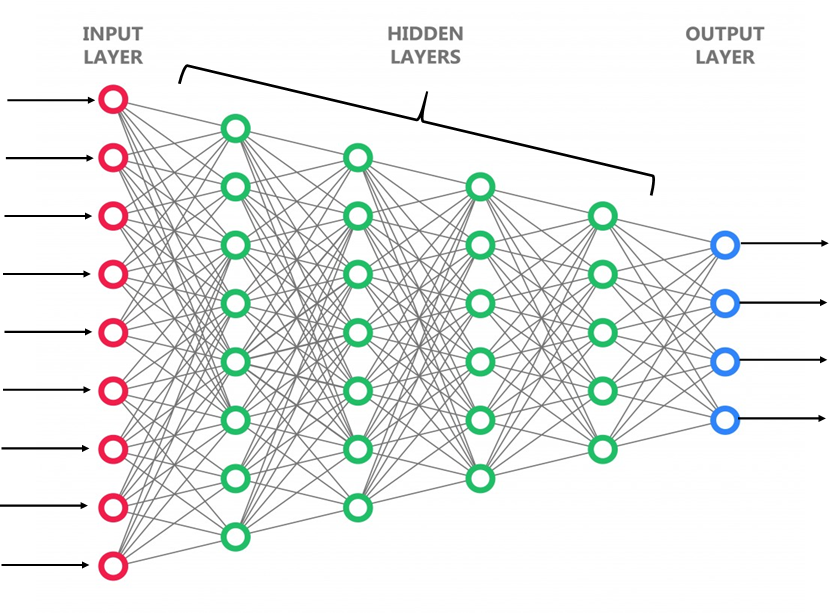Flow boiling and flow condensation in mini/micro channels is a very effective technique for meeting the high heat dissipating and heat acquisition requirements of thermal management systems. However, accurate prediction of heat transfer coefficients remains an elusive task because of the complex fluid and thermal behavior in these two-phase systems. While various techniques are currently used for predicting two-phase performance parameters, including empirical/semi-empirical correlations, analytical models, and CFD simulations, all of them have their own shortcomings.
Performance parameters like heat transfer coefficients and pressure drops in two-phase flows are usually a function of many independent dimensionless groups, each of them valid over a finite range of values. The relationship between these parameters and their relevance to heat transfer coefficients can be deduced using new machine learning techniques. We are investigating the use of various ML tools to predict these parameters and seeing extreme good success in their predicting capability in comparison to traditional techniques.
Related Publications
[9] S. Chang, Y. Suh, C. Shingote, C.-N. Huang, I. Mudawar, C. Kharangate, Y. Won, BubbleMask: Autonomous visualization of digital flow bubbles for predicting critical heat flux, Int J Heat Mass Transf. 217 (2023) 124656. https://doi.org/10.1016/J.
[8] Y Qiu, T Vo, D Garg, H Lee, CR Kharangate, A systematic approach to optimization of ANN model parameters to predict flow boiling heat transfer coefficient in mini/micro-channel heatsinks, International Journal of Heat and Mass Transfer 202, 123728. https://doi.org/10.1016/j.ijheatmasstransfer.2022.123728
[7] K. Kim, H. Lee, M. Kang, G. Lee, K. Jung, C.R. Kharangate, M. Asheghi, K.E. Goodson, H. Lee, A machine learning approach for predicting heat transfer characteristics in micro-pin fin heat sinks, Int J Heat Mass Transf. 194 (2022) 123087. https://doi.org/10.1016/j.ijheatmasstransfer.2022.123087
[6] A. Bard, Y. Qiu, C.R. Kharangate, R. French, Consolidated modeling and prediction of heat transfer coefficients for saturated flow boiling in mini/micro-channels using machine learning methods, Applied Thermal Engineering. 210 (2022) 118305. https://doi.org/10.1016/J.APPLTHERMALENG.2022.118305.
[5] E. Cho, H. Lee, M. Kang, D. Jung, G. Lee, S. Lee, C.R. Kharangate, H. Ha, S. Huh, H. Lee, A neural network model for free-falling condensation heat transfer in the presence of non-condensable gases, Int. J. Therm. Sci. 171 (2022) 107202. https://doi.org/10.1016/J.IJTHERMALSCI.2021.107202.
[4] Y. Qiu, D. Garg, S.M. Kim, I. Mudawar, C.R. Kharangate, Machine learning algorithms to predict flow boiling pressure drop in mini/micro-channels based on universal consolidated data, Int. J. Heat Mass Transf. 178 (2021) 121607. https://doi.org/10.1016/J.IJHEATMASSTRANSFER.2021.121607.
[3] H. Lee, M. Kang, K. Wook, C.R. Kharangate, S. Lee, M. Iyengar, C. Malone, M. Asheghi, K.E. Goodson, H. Lee, An artificial neural network model for predicting frictional pressure drop in micro-pin fin heat sink, Appl. Therm. Eng. 194 (2021) 117012. https://doi.org/10.1016/j.applthermaleng.2021.117012.
[2] L Zhou, D Garg, Y Qiu, SM Kim, I Mudawar, CR Kharangate, Machine learning algorithms to predict flow condensation heat transfer coefficient in mini/micro-channel utilizing universal data, International Journal of Heat and Mass Transfer 162, 120351. https://doi.org/10.1016/j.ijheatmasstransfer.2020.120351
[1] Y Qiu, D Garg, L Zhou, CR Kharangate, SM Kim, I Mudawar, An artificial neural network model to predict mini/micro-channels saturated flow boiling heat transfer coefficient based on universal consolidated data, International Journal of Heat and Mass Transfer 149, 119211. https://doi.org/10.1016/j.ijheatmasstransfer.2019.119211


